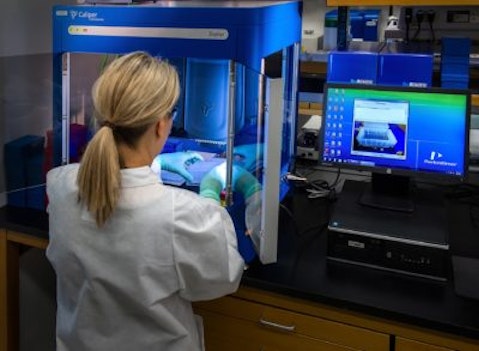Illumina, Inc. (NASDAQ:ILMN) Q2 2023 Earnings Call Transcript August 10, 2023
Operator: Good day, ladies and gentlemen, and welcome to the Second Quarter 2023 Illumina Earnings Conference Call. At this time, all participants are in a listen-only mode. After the speakers’ presentation, there will be a question-and-answer session. Please be advised that today’s conference is being recorded. I would now like to hand the conference over to Salli Schwartz, Vice President of Investor Relations.
Salli Schwartz: Hello, everyone. And welcome to our earnings call for the second quarter of 2023. During the call today, we will review the financial results released after the close of the market, and offer commentary on our commercial activity, after which we will host a question and answer session. If you have not had a chance to review the earnings release, it can be found in the Investor Relations section of our website at illumina.com. Participating for Illumina today will be Charles Dadswell, Interim Chief Executive Officer and General Counsel, and Joydeep Goswami, Chief Financial Officer and Chief Strategy and Corporate Development Officer. Chuck will provide an update on the state of Illumina’s business and Joydeep will review our financial results which include GRAIL.
As a reminder, GRAIL must be held and operated separately and independently from Illumina pursuant to the interim measures ordered by the European Commission, which prohibited our acquisition of GRAIL under the EU Merger Regulation. This call is being recorded and the audio portion will be archived in the Investor section of our website. It is our intent that all forward-looking statements regarding our financial results and commercial activity made during today’s call will be protected under the Private Securities Litigation Reform Act of 1995. Forward-looking statements are subject to risks and uncertainties. Actual events or results may differ materially from those projected or discussed. All forward-looking statements are based upon current available information, and Illumina assumes no obligation to update these statements.
To better understand the risks and uncertainties that could cause actual results to differ, we refer you to the documents that Illumina files with the Securities and Exchange Commission, including Illumina’s most recent forms 10-Q and 10-K. With that, I will now turn the call over to Chuck.
Charles Dadswell: Thank you, Salli. Good afternoon, everyone, and thank you for joining today’s call. As you know, I assumed the role of Illumina’s interim CEO two months ago. Our search for a CEO is underway, and we look forward to updating you soon. Our Board is pleased with the outstanding candidates they are seeing. Before going into our second quarter results, I wanted to take a moment to acknowledge and thank our former CEO, Francis deSouza, and our former Chairman of the Board, John Thompson, for their thoughtfulness and commitment while at Illumina. I would also like to welcome our new Board members, Stephen MacMillan, our new Chairman of the Board, as well as Andrew Teno and Scott Ullem. I also wanted to acknowledge changes in our executive leadership team, including the departures of our Chief Technology Officer, Alex Aravanis, and our Chief Medical Officer, Phil Febbo.
I speak for the whole company in wishing both of them every success in the future. We also are pleased to announce that Steve Barnard, a 25-year Illumina employee and distinguished scientist in our field, will drive Illumina’s legacy of innovation forward as our next Chief Technology Officer. We will be conducting a search for our next Chief Medical Officer. Turning to our second quarter results: In Q2, Illumina delivered revenue of approximately $1.18 billion and diluted non-GAAP EPS of $0.32, both ahead of the guidance we provided in Q1. We shipped 109 NovaSeq X instruments in the quarter and have increased our expectations for our full year supply capacity to more than 390 instruments. However, as you saw from our earnings release, we are reducing our guidance, and now expect core Illumina full year 2023 revenue to be approximately flat with 2022, primarily as a result of three factors.
First, a larger-than-expected temporary decline in high throughput consumables as we transition more-than-expected customers to the NovaSeq X. Second, many of our customers are remaining more cautious in their purchasing behaviors. And finally, in China, there is both a more protracted economic recovery and an increasingly challenged competitive landscape, in contrast to the Americas and Europe, where we are still expecting year-over-year growth in 2023. Joydeep will provide additional details on our revised guidance during his remarks. One area I’d like to touch on further is the rollout of NovaSeq X. This has been a more challenging process than we anticipated. NovaSeq X is the most sophisticated platform we have ever launched and includes the most comprehensive end-to-end software we have ever released.
Also, the rollout of the X has occurred at an unprecedented magnitude and pace. And we have identified issues in the field that are typical in new product releases. To address these issues, we have taken actions including a planned software update that was released in June after our first customer shipment in March. We have deployed Illumina technical teams worldwide to work with our customers to accelerate bringing their systems online. While the rollout of NovaSeq X will take longer than we originally expected, the continued strong interest and commitment of capital to purchase NovaSeq Xs remains encouraging. To date, 20% of customers who have purchased a NovaSeq X have ordered more than one instrument. This early demand for multiple instruments and the capacity they represent underscores our confidence that customers are planning to increase their sequencing activity.
Customers have clear intentions to do more sequencing in the future: Our customers have commented that larger scale single cell and spatial analysis experiments become more practical with the NovaSeq X, and they are requesting funding for these applications. Customers engaged in large population genomics initiatives have stated they plan to run additional multiomic programs for population-specific variants, which can be used to develop treatments for various demographics that will be more effective in those populations. And, as some of you have heard, several of our largest customers are using the X to accelerate the move from targeted panels and exomes to whole genome sequencing. We expect these types of projects to scale and ramp in the near future, and we will be closely engaged with our customers to support their needs.
We continue to consciously and actively reduce our expense base and have accelerated actions within the $100 million-plus annual run rate expense reduction program we announced at our last earnings call. As you saw in our late June 8K filing, we have reduced our global headcount and are downsizing our global real estate footprint. We also are optimizing our third-party vendor spend and have reduced travel-related and other costs. For 2023, these steps are helping mitigate the impact of lower full-year revenue on our operating margin. Looking forward, these actions will continue to support our margins and create flexibility for further investment in high-growth areas. Let me give you an update on a couple of our platforms: We saw continued global interest in the NovaSeq X series in Q2, and we exited the quarter with more than 260 orders since launch.
Our shipments of 109 NovaSeq X instruments in Q2 were above our expectation of 80 for the quarter and brought our total installed base to 176 instruments. We now expect to be able to ship more than 390 NovaSeq X instruments this year, up from the 330 we had previously expected for the year. In mid-throughput, we shipped approximately 160 NextSeq 1k/2k units in the second quarter, an increase of 8% year-over- year, as customers expanded their current fleets or migrated from the MiSeq or NextSeq 550. More than 20% of NextSeq 1k/2k units in Q2 were placed with new-to-Illumina customers. We continue to experience lengthened sales cycles, in some cases as customers take time to raise funding or prioritize their investment dollars, and in other cases as they run longer procurement processes.
Our win rate across the midthroughput segment, outside of China, increased from the first quarter. We believe there is a long runway of differentiation for the 1k/2k, notably with X-LEAP SBS chemistry coming available on these instruments next year. Moving to our markets. In Q2, clinical represented approximately 53% of our total sequencing consumables revenue. In oncology, progress continued for next generation sequencing-based testing reimbursement. Anthem, the second largest commercial payer in the US, and Blue Cross Blue Shield of Michigan, both added coverage for comprehensive genomic profiling for patients with advanced cancers, adding more than 30 million additional covered lives. We also saw coverage continue to progress in Europe, with Switzerland now reimbursing large next generation sequencing panels, including comprehensive genomic profiling.
Illumina’s market leading TruSight Oncology assay, TSO 500, remains on track to exceed more than $100 million in 2023 revenue. Growth continues to be driven by greater utilization and broader adoption of our assay. In Q2, we also completed our TSO Comprehensive submission for IVD registration in the United States. Also in oncology, GRAIL continues to achieve solid progress in the adoption of its Galleri multi-cancer early detection test. In Q2, GRAIL achieved its 100,000th commercial Galleri test milestone, and the test has now been prescribed by more than 7,500 providers in the US and ordered in more than 80 health systems. As an update, on the NHS-Galleri study, in Q2 GRAIL completed second-year follow up visits, in which 130,000 participants returned, giving the trial a retention rate of 91.3%.
Invitations for the third and final-year visits have begun, and the first appointments for those visits are expected this fall. Evidence for Galleri continues to grow. At the most recent annual meeting held by the American Society of Clinical Oncology, GRAIL announced results from the University of Oxford-sponsored SYMPLIFY study, reporting high specificity, positive predictive value, and accuracy of the cancer signal detected and cancer signal origin prediction, as well as demonstrating the feasibility of using an MCED test to assist clinicians with decisions regarding referrals from primary care physicians. GRAIL is also making progress on its unique multi-cancer minimal residual disease test. At the American Association for Cancer Research annual meeting, GRAIL and AstraZeneca presented new data that supports use of GRAIL’s methylation platform to identify residual cancer in post-treatment settings.
GRAIL’s technology had a cancer detection rate of 92% in patients with relapsed or refractory disease across six hematological malignancies. These findings demonstrate that GRAIL’s blood-based methylation approach offers additional options to clinicians as they evaluate patients in efforts to achieve remission and improve survival. Returning to core Illumina, in reproductive health, in the US, five state Medicaid programs – in Louisiana, Michigan, North Carolina, Rhode Island and Tennessee – updated their policies and are now covering non-invasive prenatal testing for all pregnancies. In Europe, NIPT is now available for all pregnancies in the Netherlands and has been approved for broader coverage in Italy. Turning to our research and applied markets, as we announced in mid-July, the Alliance for Genomic Discovery, launched by Illumina and Nashville Biosciences in 2022, now includes five founding members – AbbVie, Amgen, AstraZeneca, Bayer, and Merck – and represents a novel, industry-led collaboration to accelerate development of therapeutics through large-scale genomics.
Members will co-fund the whole-genome sequencing of 250,000 samples and all have access to the resulting data for use in drug discovery and therapeutic development. The first phase in the Alliance was announced in January and involved whole-genome sequencing for 35,000 samples, primarily made up of DNA from individuals of African ancestry. Before we move to Joydeep and then go to Q&A, I wanted to point out a couple of additional innovations we recently announced. In June, our PrimateAI-3D, an AI algorithm that predicts disease-causing genetic mutations in patients with unprecedented accuracy, was featured in articles and as the cover story of Science magazine’s June issue. And in July, we announced the latest version of our DRAGEN software for analysis of next-generation sequencing data.
DRAGEN 4.2 expands award-winning accuracy combined with flexibility and scalability to enable efficient workflows and extract meaningful insights from genomic data. It improves identification of the causes of genetic disease and further aids in both drug discovery and population genomics analysis. While the year hasn’t progressed the way we expected, we remain focused on execution, innovation, and supporting our customers as they ramp their NovaSeq X instruments. We continue to progress on margin improvement while prioritizing investment in proprietary technology that generates differentiated products that are valued by our customers and will drive growth. These include upcoming product launches, including the highly anticipated 25B flow cell for the NovaSeq X, the Illumina Complete Long Reads enrichment assay, and XLEAP-SBS chemistry on NextSeq 1k/2k, as well as future offerings for emerging markets like proteomics, multiomics, and spatial, where we see opportunities to address researchers’ needs and deliver complete, integrated, and accessible workflows.
In short, Illumina will continue to deliver impactful outcomes. We empower researchers and clinicians with the data and technology they need to make life-changing discoveries and decisions for patients. Our employees take pride in being part of Illumina’s mission to improve human health by unlocking the power of the genome. And we are the global engine of genomics innovation, positioning us today and in the future to maximize shareholder value. With that, I’d like to turn the call over to Joydeep to discuss additional details on our results and outlook, and we’ll go from there to Q&A. Joydeep?
Joydeep Goswami: Thank you, Chuck. I’ll start by reviewing our consolidated financial results, followed by segment results for core Illumina and GRAIL, and then conclude with my remarks on our current outlook for 2023. I will be discussing non-GAAP results which include stock-based compensation. I encourage you to review the GAAP reconciliation of these non-GAAP measures which can be found in today’s release and in the supplementary data available on our website. As Chuck noted, in the second quarter, consolidated revenue was $1.18 billion, up 8% from the first quarter of 2023 and exceeding the high end of our guidance range on stronger than expected shipments of NovaSeq X. Consolidated revenue was up 1% year-over-year, and up 3% on a constant currency basis.
Non-GAAP net income was $50 million, or $0.32 per diluted share, which includes dilution from GRAIL’s non-GAAP operating loss of $164 million for the quarter. Non-GAAP EPS exceeded our expectations primarily due to continued execution of expense reduction initiatives, gross margin favorability, and our higher revenue for the quarter. Our non-GAAP tax rate was 39.3% for the quarter, which increased from 25.8% in Q2 2022, with both quarters reflecting the impact of R&D capitalization requirements. Although the non-GAAP tax expense impact of R&D capitalization requirements in dollars was the same in both periods, the impact to our effective tax rate in Q2 2023 was more significant due to our lower earnings. Our non-GAAP weighted average diluted share count for the quarter was approximately 158 million.
Moving to segment results. Core Illumina revenue of $1.16 billion was approximately flat year-over-year, or up 2% on a constant currency basis, which included an anticipated reduction from COVID surveillance of approximately 180 basis points. COVID surveillance contributed approximately $6 million in total revenue in Q2 2023 compared to $27 million in Q2 2022. Core Illumina sequencing consumables revenue of $739 million was down 1% year-over-year. Mid-teens growth in clinical led by continued momentum in oncology and genetic disease testing was offset by anticipated headwinds impacting research, including an approximately 260 basis point reduction from COVID surveillance, as well as sanctions in Russia, the impact on NovaSeq 6K consumables as customers start to transition to, but before they have fully ramped up on NovaSeq X, and constrained funding impacting many of our customers globally.
Total sequencing activity on our connected high- and mid-throughput instruments grew 3% from Q1 2023 and 9% year-over-year. Research and applied was flat from Q1 and declined 1% year-over-year. Clinical sequencing activity growth remained strong, up 6% from Q1 and 23% year-over-year. As a reminder, we believe this data is a useful reference that shows the general activity trends across our installed base and is directionally correlated with revenue over time. We have been providing this information on the basis of number of sequencing runs, but in the future we will disclose these metrics in terms of gigabases sequenced to better reflect activity trends given the significant increase in output per run enabled by NovaSeq X and NextSeq 1K/2K.
Sequencing instruments revenue for Core Illumina of $193 million grew 2% year-over-year. Stronger-than-expected shipments of NovaSeq X more than offset the anticipated decline in NovaSeq 6000 shipments globally and NextSeq 550 placements in China, as well as a decrease in MiSeq shipments as customers transition to NextSeq 1K/2K. We continued to see strong demand for NextSeq 1K/2K from new-to-Illumina customers, with shipments growing 8% year-over-year. Core Illumina sequencing service and other revenue of $134 million was up 7% year-over-year, driven primarily by higher instrument service contract revenue on a growing installed base, partially offset by lower contributions from codevelopment partnerships. Moving to regional results for Core Illumina.
All regions continued to be impacted by tighter funding and budget pressures that are affecting customers’ project planning and purchasing behaviors. Additionally, all regions faced the impact of high throughput customers transitioning to NovaSeq X, where we saw customers reduce NovaSeq 6K consumables purchases before they have fully ramped up activity on NovaSeq X. As Chuck mentioned, that though anticipated, this effect was magnified by the larger than expected number of NovaSeq X deliveries and a slower than expected ramp of these instruments coming online in Q2. Continued global demand for NovaSeq X instruments and our stronger-than-anticipated supply in Q2 helped offset these factors. Strong momentum in clinical also continued across the Americas, Europe and AMEA, with consumables shipments to clinical customers in these regions growing just under 20% year-over-year.
Europe also benefited from the NIPT reimbursement decision in Germany last year and the national NIPT program in the Netherlands. Americas revenue of $623 million was down 2% year-over-year, and Europe revenue of $303 million grew 11% year-over-year, or 14% on a constant currency basis. AMEA revenue of $118 million declined 10% year-over-year, or 6% on a constant currency basis, which included a 14 percentage point impact from sanctions affecting our ability to conduct business in Russia. As a reminder, these regions also continued to be impacted by the slowdown in COVID surveillance year-over-year. Greater China revenue of $115 million represented a 3% decrease year-over-year, or a 1% increase on a constant currency basis. In addition to persistent macroeconomic and geopolitical challenges that are impacting this region, revenue was negatively impacted by the local competitive landscape, particularly in mid-throughput.
Moving to the rest of the Core Illumina P&L. Core Illumina non-GAAP gross margin of 67.0% decreased 280 basis points year-over-year. primarily driven by lower instrument margins due to the NovaSeq X launch, which is typical in a launch year, as well as less fixed cost leverage on lower manufacturing volumes, and higher field services and installation costs. Core Illumina non-GAAP operating expenses of $531 million were up $12 million year-over-year primarily due to the full year impact of our headcount growth in 2022. Non-GAAP operating expenses were lower than expected due to the acceleration of our expense reduction initiatives and lower performance-based compensation. As a result of the above, Core Illumina non-GAAP operating margin was 21.2% in Q2 2023 compared to 24.9% in Q2 2022.
Transitioning to the financial results for GRAIL. GRAIL revenue of $22 million for the quarter grew 83% year-over-year, driven primarily by accelerating adoption of Galleri. GRAIL non-GAAP operating expenses totaled $174 million and increased $18 million year-over-year, driven primarily by continued investments to scale GRAIL’s commercial organization. Moving to consolidated cash flow and balance sheet items. Cash flow provided by operations was $105 million. Second quarter 2023 capital expenditures were $47 million and free cash flow was $58 million. We did not repurchase any common stock in the quarter. We ended the quarter with approximately $1.6 billion in cash, cash equivalents and short-term investments. As you are aware, we have $750 million in convertible debt that matures this month.
Additionally, on July 12, 2023, the European Commission imposed a €432 million fine on Illumina due to the completion of the GRAIL acquisition during the pendency of the European Commission’s review. We plan to issue a guarantee and defer the payment of the fine pending the outcome of the appeal of the EU General Court’s ruling that the European Commission has jurisdiction to review the GRAIL acquisition. Moving now to 2023 guidance. We now expect full year 2023 consolidated revenue to grow approximately 1%, including Core Illumina revenue that’s approximately flat with 2022. As a reminder, these ranges include anticipated reductions from COVID surveillance of approximately 200 basis points, the impact on our business from sanctions on Russia of approximately 100 basis points, as well as a year-over-year negative impact from foreign exchange rates.
GRAIL revenue is still expected to be in the range of $90 million to $110 million for 2023. For fiscal 2023, we now expect Core Illumina sequencing instrument revenue growth of approximately 3% year-over-year reflecting our higher NovaSeq X shipment expectation, partially offset by capital and cash flow constraints that have continued to impact our customers’ purchasing behaviors, including in China which also had an increased impact from local competition, primarily affecting mid-throughput. We also expect Core Illumina sequencing consumables revenue to decline approximately 3% year-over-year, driven predominately by, one, a more persistent impact of funding issues and cautious purchasing behaviors causing project delays; a more meaningful decrease in NovaSeq 6000 sequencing ahead of planned transitions to NovaSeq X, in part due to our higher shipment expectations for NovaSeq X; three, a delay in the expected ramp of consumables on NovaSeq X; and four, a slower than anticipated second-half recovery in China.
We now expect annual pull-through for NovaSeq 6000 of approximately $800,000 to $900,000 per instrument in 2023, NextSeq 550 pull-through in the range of $80,000 to $130,000, and pull-through for MiSeq in the range of $30,000 to $40,000. We still expect pull through for NextSeq 1K/2K to be within the historical guidance range of $120,000 to $170,000 and MiniSeq pull through is still expected to be within the historical range of $20,000 to $25,000 per instrument. With regard to Core Illumina sequencing revenue, we expect it to be approximately flat year-over-year. This includes intercompany sales to GRAIL of approximately $30 million, which are eliminated in consolidation. We now expect consolidated non-GAAP operating margin of approximately 5% and Core Illumina non-GAAP operating margin of approximately 20%.
Our revised operating margins reflect our lower revenue expectations for the year and lower gross margins given lower manufacturing volumes and fixed cost leverage. These impacts are partially offset by acceleration of our $100 million-plus annual run rate expense reduction initiatives spanning headcount, real estate, and other costs that Chuck mentioned earlier. We now expect our non-GAAP tax rate to be approximately 41% for 2023, which continues to include an approximately $75 million tax expense impact from R&D capitalization requirements. Although the non-GAAP tax expense impact of R&D capitalization requirements in dollars hasn’t changed, the impact to our effective tax rate in 2023 has increased as a result of our lower earnings. Lastly, we now expect non-GAAP earnings per diluted share in the range of $0.75 to $0.90 for 2023, which continues to include dilution from GRAIL’s non-GAAP operating loss of approximately $670 million.
Before we go to Q&A, I’d like to cover guidance for the third quarter of 2023. We expect Q3 2023 consolidated revenue to grow approximately 2% year-over-year to approximately $1.14 billion. This reflects a sequential decrease of approximately 320 basis points from Q2 2023, primarily driven by a sequential decrease in NovaSeq 6000 consumables as customers continue to transition to NovaSeq X. For the third quarter, we expect non-GAAP diluted EPS of approximately $0.10 to $0.15, reflecting consolidated non-GAAP operating margin of approximately 4% and Core Illumina non-GAAP operating margin of approximately 19%. I will now invite the operator to open the line for Q&A. Thank you.
See also Wall Street Analysts Trim Price Targets for These 10 Stocks and 15 Cheapest Legal Weed States to Live in.
Q&A Session
Follow Illumina Inc. (NASDAQ:ILMN)
Follow Illumina Inc. (NASDAQ:ILMN)
Operator: [Operator Instructions]. And our first question will come from Puneet Souda with Leerink Partners.
Puneet Souda: The NovaSeq field challenges that you’re having in the market, can you talk a little bit about that? How soon can you fix these challenges? What is getting this recovery? And what does that mean for the installs in the third and fourth quarter and maybe even 2024? My question there is, the market sort of freezes to see if these challenges are resolved before taking on more instruments? And then, on the elasticity of demand, clearly, there is significantly more higher dip this year, there’s a decline in sequencing consumables versus when we look at the last product launch of NovaSeq 6000. You mentioned a number of factors, but just trying to understand how much of that is due to the challenges that you’re facing in the field. And, look, the NovaSeq is definitely selling despite the challenges, so maybe could you just update us on the CEO search as well?
Charles Dadswell: I’ve been listening to you guys now for a long time and it’s nice to be able to be part of the conversation. So as far as the NovaSeq X, some of the positives of the launch of an instrument of this magnitude are that we’ve placed more instruments than we thought. It also has some of the biggest software placements that we’ve ever seen. And it’s revolutionary from the ground up. What we did is we underestimated the amount of time it would ultimately take to bring these instruments online. But our technical teams are working with our customers to bring them up to speed as quickly as we can.
Joydeep Goswami: Puneet, maybe I’ll jump in. A couple of things. First, as you know, with any of these launches of this magnitude, as you go out into the field, and as you start installing it, you find some bugs that you have to go resolve. So what we have seen in Q2 was nothing out of the ordinary. We have actually – already have fixes for the issues that we have seen and are in the process of deploying these fixes to our customers. So it has meant a little bit of delay in our original expectations of when these instruments would be fully up to speed. But it hasn’t changed any of our or our customer expectations on NovaSeq X. And I will also really urge you to consider that it’s not all customers that see this. So some customers are fully [Technical Difficulty], while others, as they have experienced these issues, we are really all hands on deck to go fix these issues in the field.
The other thing is that you talked about elasticity in terms of volume increase and sequencing volume increase. Look, we’re not seeing any fundamental change to elasticity. The issues that you’ve seen are more related to transition to the X. So what we have seen is because of the larger number of Xs installed in the in the area because we moved up some of the supply of Xs, we have seen that the decline in the 6k consumables has been faster and larger than we had expected. Again, this is the flip side of people really being excited about the X and our ability to deliver more Xs. So that’s what has happened. It’s a temporary decline. And we expect that as we ramp up fully on the on the Xs that that volume will come back on in terms of X consumables.
But what you’re seeing now is this timing gap that we have between those two events. And you said something about – I think there was – whether these challenges on the X are continuing or they’ll cause a stall in the market. actually, they haven’t caused a stall in the market. We have seen demand for the X and our late stage pipeline continue to ramp up. As Chuck mentioned in his prepared remarks that we have seen the X actually enable experiments and solutions that were not hitherto possible. So we do see continued interest in the X and the continued interest in doing things that were not possible before. And, Chuck, I’ll turn it back over to you to for the CEO search.
Charles Dadswell: In regards to the CEO search, the board’s actively searching for our new CEO. The search includes both internal and external candidates. They’ve been really encouraged about the outstanding quality of candidates they’re seeing. But, of course, you know that the details of the board’s processes on this are confidential. We’ll be able to update you as soon as we can.
Operator: And our next question will come from Dan Brennan with TD Cowen.
Dan Brennan: Maybe a couple here packed into one, I guess. The $25 billion flow cell, is that still on track? When will that ship, given some of the issues that you’ve cited? Second part, China. China actually grew in the quarter, but I know you called out some pressure there. So kind of what’s baked in now for China in the back half of the year. Third part would be, reference customer challenges throughout which obviously the broader tool spaces that are really challenging second quarter, but that said, the academic and government end market has actually been pretty robust outside of China. So I’m wondering if you can discuss a little bit where are you seeing these challenges? And then the final point would just be on the NovaSeq consumable pull-through card, and you’re mentioning customers are switching faster over to the X.
I guess, how do we get comfortable that you’re not seeing some either competitive impact or some dampening of utilization, I guess. Kind of what was different this time around, do you think, in terms of your forecasting versus [indiscernible] management forecasted during the last cycle?
Charles Dadswell: I think, first, we continue to prioritize our investments. They’re proprietary and we still continue to focus on the differentiation of products. We probably have the biggest and the best proprietary pipeline in the industry. And we continue to lean on it. The 25b flow cell remains on track for launch in second half of 2023. We continue to push forward on the Illumina CLR enrichment assay. That’s particularly compelling when you’re using it with the 25B flow cell. We continue to move forward on the X-LEAP SBS chemistry for NovaSeq 1k/2k. And we’re going to have future offerings for emerging markets for things like proteomics, multiomics, and spatial






